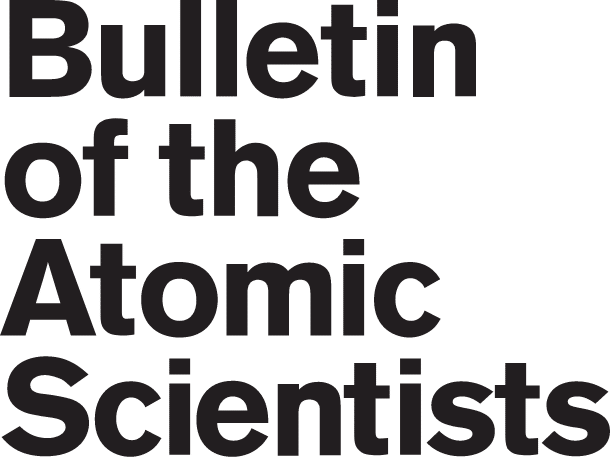modernize their nuclear triads—thereby undermining existing nuclear weapons treaties. “The clock ticks now at just three minutes to midnight because international leaders are failing to perform their most important duty— ensuring and preserving the health and vitality of human civilization.”
 2012 IT IS 5 MINUTES TO MIDNIGHT “The challenges to rid the world of nuclear weapons, harness nuclear power, and meet the nearly inexorable climate disruptions from global warming are complex and interconnected. In the face of such complex problems, it is difficult to see where the capacity lies to address these challenges.” Political processes seem wholly inadequate; the potential for nuclear weapons use in regional conflicts in the Middle East, Northeast Asia, and South Asia are alarming; safer nuclear reactor designs need to be developed and built, and more stringent oversight, training, and attention are needed to prevent future disasters; the pace of technological solutions to address climate change may not be adequate to meet the hardships that large-scale disruption of the climate portends.
2012 IT IS 5 MINUTES TO MIDNIGHT “The challenges to rid the world of nuclear weapons, harness nuclear power, and meet the nearly inexorable climate disruptions from global warming are complex and interconnected. In the face of such complex problems, it is difficult to see where the capacity lies to address these challenges.” Political processes seem wholly inadequate; the potential for nuclear weapons use in regional conflicts in the Middle East, Northeast Asia, and South Asia are alarming; safer nuclear reactor designs need to be developed and built, and more stringent oversight, training, and attention are needed to prevent future disasters; the pace of technological solutions to address climate change may not be adequate to meet the hardships that large-scale disruption of the climate portends.
 2010 IT IS 6 MINUTES TO MIDNIGHT International cooperation rules the day. Talks between Washington and Moscow for a follow-on agreement to the Strategic Arms Reduction Treaty are nearly complete, and more negotiations for further reductions in the U.S. and Russian nuclear arsenal are already planned. Additionally, Barack Obama becomes the first U.S. president to publicly call for a nuclear-weapon-free world. The dangers posed by climate change are still great, but there are pockets of progress. Most notably: At Copenhagen, the developing and industrialized countries agree to take responsibility for carbon emissions and to limit global temperature rise to 2 degrees Celsius.
2010 IT IS 6 MINUTES TO MIDNIGHT International cooperation rules the day. Talks between Washington and Moscow for a follow-on agreement to the Strategic Arms Reduction Treaty are nearly complete, and more negotiations for further reductions in the U.S. and Russian nuclear arsenal are already planned. Additionally, Barack Obama becomes the first U.S. president to publicly call for a nuclear-weapon-free world. The dangers posed by climate change are still great, but there are pockets of progress. Most notably: At Copenhagen, the developing and industrialized countries agree to take responsibility for carbon emissions and to limit global temperature rise to 2 degrees Celsius.

 2017 IT IS TWO AND A HALF MINUTES TO MIDNIGHT For the last two years, the minute hand of the Doomsday Clock stayed set at three minutes before the hour, the closest it had been to midnight since the early 1980s. In its two most recent annual announcements on the Clock, the Science and Security Board warned: “The probability of global catastrophe is very high, and the actions needed to reduce the risks of disaster must be taken very soon.” In 2017, we find the danger to be even greater, the need for action more urgent. It is two and a half minutes to midnight, the Clock is ticking, global danger looms. Wise public officials should act immediately, guiding humanity away from the brink. If they do not, wise citizens must step forward and lead the way.
2017 IT IS TWO AND A HALF MINUTES TO MIDNIGHT For the last two years, the minute hand of the Doomsday Clock stayed set at three minutes before the hour, the closest it had been to midnight since the early 1980s. In its two most recent annual announcements on the Clock, the Science and Security Board warned: “The probability of global catastrophe is very high, and the actions needed to reduce the risks of disaster must be taken very soon.” In 2017, we find the danger to be even greater, the need for action more urgent. It is two and a half minutes to midnight, the Clock is ticking, global danger looms. Wise public officials should act immediately, guiding humanity away from the brink. If they do not, wise citizens must step forward and lead the way. 2016 IT IS STILL 3 MINUTES TO MIDNIGHT “Last year, the Science and Security Board moved the Doomsday Clock forward to three minutes to midnight, noting: ‘The probability of global catastrophe is very high, and the actions needed to reduce the risks of disaster must be taken very soon.’ That probability has not been reduced. The Clock ticks. Global danger looms. Wise leaders should act—immediately.”
2016 IT IS STILL 3 MINUTES TO MIDNIGHT “Last year, the Science and Security Board moved the Doomsday Clock forward to three minutes to midnight, noting: ‘The probability of global catastrophe is very high, and the actions needed to reduce the risks of disaster must be taken very soon.’ That probability has not been reduced. The Clock ticks. Global danger looms. Wise leaders should act—immediately.” 2002 IT IS 7 MINUTES TO MIDNIGHT Concerns regarding a nuclear terrorist attack underscore the enormous amount of unsecured—and sometimes unaccounted for—weapon-grade nuclear materials located throughout the world. Meanwhile, the United States expresses a desire to design new nuclear weapons, with an emphasis on those able to destroy hardened and deeply buried targets. It also rejects a series of arms control treaties and announces it will withdraw from the Anti-Ballistic Missile Treaty.
2002 IT IS 7 MINUTES TO MIDNIGHT Concerns regarding a nuclear terrorist attack underscore the enormous amount of unsecured—and sometimes unaccounted for—weapon-grade nuclear materials located throughout the world. Meanwhile, the United States expresses a desire to design new nuclear weapons, with an emphasis on those able to destroy hardened and deeply buried targets. It also rejects a series of arms control treaties and announces it will withdraw from the Anti-Ballistic Missile Treaty. 1998 IT IS 9 MINUTES TO MIDNIGHT India and Pakistan stage nuclear weapons tests only three weeks apart. “The tests are a symptom of the failure of the international community to fully commit itself to control the spread of nuclear weapons— and to work toward substantial reductions in the numbers of these weapons,” a dismayed Bulletin reports. Russia and the United States continue to serve as poor examples to the rest of the world. Together, they still maintain 7,000 warheads ready to fire at each other within 15 minutes.
1998 IT IS 9 MINUTES TO MIDNIGHT India and Pakistan stage nuclear weapons tests only three weeks apart. “The tests are a symptom of the failure of the international community to fully commit itself to control the spread of nuclear weapons— and to work toward substantial reductions in the numbers of these weapons,” a dismayed Bulletin reports. Russia and the United States continue to serve as poor examples to the rest of the world. Together, they still maintain 7,000 warheads ready to fire at each other within 15 minutes. 1995 IT IS 14 MINUTES TO MIDNIGHT Hopes for a large post-Cold War peace dividend and a renouncing of nuclear weapons fade. Particularly in the United States, hard-liners seem reluctant to soften their rhetoric or actions, as they claim that a resurgent Russia could provide as much of a threat as the Soviet Union. Such
1995 IT IS 14 MINUTES TO MIDNIGHT Hopes for a large post-Cold War peace dividend and a renouncing of nuclear weapons fade. Particularly in the United States, hard-liners seem reluctant to soften their rhetoric or actions, as they claim that a resurgent Russia could provide as much of a threat as the Soviet Union. Such 1991 IT IS 17 MINUTES TO MIDNIGHT With the Cold War officially over, the United States and Russia begin making deep cuts to their nuclear arsenals. The Strategic Arms Reduction Treaty greatly reduces the number of strategic nuclear weapons deployed by the two former adversaries. Better still, a series of unilateral initiatives remove most of the intercontinental ballistic missiles and bombers in both countries from hair-trigger alert. “The illusion that tens of thousands of nuclear weapons are a guarantor of national security has been stripped away,” the Bulletin declares.
1991 IT IS 17 MINUTES TO MIDNIGHT With the Cold War officially over, the United States and Russia begin making deep cuts to their nuclear arsenals. The Strategic Arms Reduction Treaty greatly reduces the number of strategic nuclear weapons deployed by the two former adversaries. Better still, a series of unilateral initiatives remove most of the intercontinental ballistic missiles and bombers in both countries from hair-trigger alert. “The illusion that tens of thousands of nuclear weapons are a guarantor of national security has been stripped away,” the Bulletin declares. 1990 IT IS 10 MINUTES TO MIDNIGHT As one Eastern European country after another (Poland, Czechoslovakia, Hungary, Romania) frees itself from Soviet control, Soviet General Secretary Mikhail Gorbachev refuses to intervene, halting the ideological battle for Europe and significantly diminishing the risk of all-out nuclear war. In late 1989, the Berlin Wall falls, symbolically ending the Cold War. “Forty-four years after Winston Churchill’s ‘Iron Curtain’ speech, the myth of monolithic communism has been shattered for all to see,” the Bulletin proclaims.
1990 IT IS 10 MINUTES TO MIDNIGHT As one Eastern European country after another (Poland, Czechoslovakia, Hungary, Romania) frees itself from Soviet control, Soviet General Secretary Mikhail Gorbachev refuses to intervene, halting the ideological battle for Europe and significantly diminishing the risk of all-out nuclear war. In late 1989, the Berlin Wall falls, symbolically ending the Cold War. “Forty-four years after Winston Churchill’s ‘Iron Curtain’ speech, the myth of monolithic communism has been shattered for all to see,” the Bulletin proclaims. 1981 IT IS 4 MINUTES TO MIDNIGHT The Soviet invasion of Afghanistan hardens the U.S. nuclear posture. Before he leaves office, President Jimmy Carter pulls the United States from the Olympic Games in Moscow and considers ways in which the United States could win a nuclear war. The rhetoric only intensifies with the election of Ronald Reagan as president. Reagan scraps any talk of arms control and proposes that the best way to end the Cold War is for the United States to win
1981 IT IS 4 MINUTES TO MIDNIGHT The Soviet invasion of Afghanistan hardens the U.S. nuclear posture. Before he leaves office, President Jimmy Carter pulls the United States from the Olympic Games in Moscow and considers ways in which the United States could win a nuclear war. The rhetoric only intensifies with the election of Ronald Reagan as president. Reagan scraps any talk of arms control and proposes that the best way to end the Cold War is for the United States to win 1972 IT IS 12 MINUTES TO MIDNIGHT The United States and Soviet Union attempt to curb the race for nuclear superiority by signing the Strategic Arms Limitation Treaty (SALT) and the Anti-Ballistic Missile (ABM) Treaty. The two treaties force a nuclear parity of sorts. SALT limits the number of ballistic missile launchers either country can possess, and the ABM Treaty stops an arms race in defensive weaponry from developing.
1972 IT IS 12 MINUTES TO MIDNIGHT The United States and Soviet Union attempt to curb the race for nuclear superiority by signing the Strategic Arms Limitation Treaty (SALT) and the Anti-Ballistic Missile (ABM) Treaty. The two treaties force a nuclear parity of sorts. SALT limits the number of ballistic missile launchers either country can possess, and the ABM Treaty stops an arms race in defensive weaponry from developing.